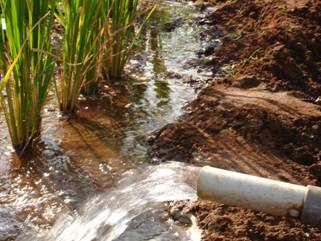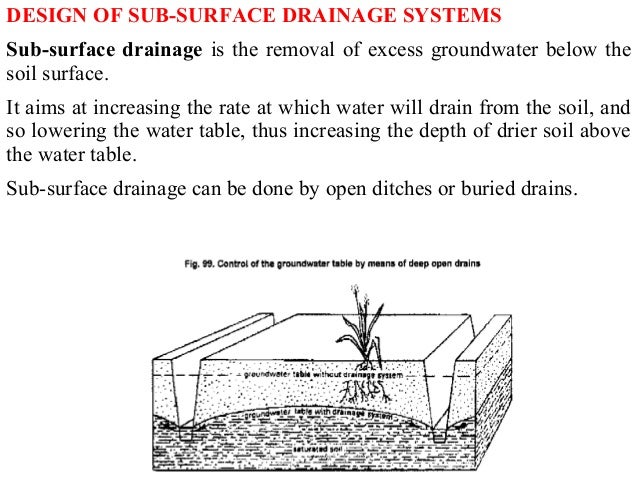UNIT 4. IRRIGATION AND DRAINAGE
Watch this video about modern irrigation methods to introduce this unit:
DEFINITIONS
Supply: an amount
or store of something (food, water, power, gas, electricity, etc.) that can be
provided or used if necessary. (suministro)
Dams: a barrier to
obstruct or control the flow of water, built across a stream or river (presa)
Reservoir
/ˈrɛzəˌvwɑː/: a natural or
artificial place where water is collected for use, supplying a community or
region. (pantano)
Spillway: a passageway
through which extra water escapes from a reservoir, lake, or the like. (desagüe,
aliviadero)
Well:
a hole drilled into the earth to obtain a natural deposit, as water or
petroleum. (pozo)
Aquifer: any geological
formation containing or conducting ground water, esp. one that supplies the
water for wells, springs, etc. (acuífero)
Silt: earth carried by moving water and deposited as a sediment. (limo)
Dew: moisture condensed from the atmosphere, esp. at night,
and deposited in the form of small drops upon any cool surface. (rocío)
Sewage /ˈsuːɪdʒ/: waste matter from domestic or industrial establishments that
is carried away in sewers (alcantarillado, cloaca) or drains (desagües) for
dumping (vertido) or conversion into a form that is not toxic. (traducción:
aguas residuales)
Weir /wɪə/: a small dam in a river or
stream. (azud)
A pump: an apparatus or machine for raising, driving, exhausting, or
compressing fluids or gases by means of a piston, plunger (émbolo), or set of
rotating vanes (aspas giratorias). (bomba)
To pump: to raise water with a pump.(bombear)
Sluice
/sluːs/:
water cannel.(canal)
Sprinkler: a
device for sprinkling or scattering water, usually a
perforated ring or small stand with a revolving nozzle (boquilla) to which a
hose is attached for watering a lawn.(aspersor)
To drip: provide water drop by drop. (gotear)
Dripper: a device to provide water drop by drip. (gotero)
To
Flood or a flood: cover with water or a great amount of water that cover a
surface. (inundar, inundación)
Drought
/draʊt/: a long period of
dry weather. (sequía)
Furrow:
a narrow groove (ranura, canal) made in the ground, esp. by a plow (arado).
(surco)
Pipeline:
a route or channel along which supplies (water, gas, oil, etc.) pass. (tuberías)
Seepage:
the amount of something that has leaked out. (filtración, fuga)
Irrigation
and drainage. Definitions
-Irrigation is the artificial application of
water to land.
-Drainage /dreɪnɪdʒ/ is the artificial removal of excess water from land.
Some land requires irrigation
or drainage before it is possible to use it for any agricultural production;
other land profits from either practice to increase production. Often both may
be required together to assure sustained, high-level production of crops.
IRRIGATION
The first consideration in
planning an irrigation project is
developing a water supply. Water
supplies may be classified as surface
or subsurface. Both surface and subsurface
water come from precipitation such as rain or snow.
In planning a surface water
supply, extensive studies must be made of the flow in the stream or river, including times of drought and flood. This information will determine the size of dams and spillways,
as well as the seasonal storage needed.
The quality, as well as the
quantity, of surface water is another important factor. The two most important
considerations are the amount of silt
carried and the kind and amount of salts
dissolved in the water. If the silt
content is high, sediment will
be deposited in the reservoir,
increasing maintenance costs and decreasing useful life periods. If the salt concentration is high, it may
damage crops or accumulate in the soil and eventually render it unproductive.
Subsurface sources of water
must be as carefully investigated as surface sources. We get water from
aquifers through the use of wells. If a well is drilled in the right location,
the pressure will cause it to flow on its own. If not, mechanical energy must
be used to extract the ground water. In the past hand pumps were used. Modern
wells use another energy source to pump the water, such as electricity.
Two sources of water not often
thought of by the layman are dew and
sewage. They are used mainly in arid
regions.
In certain parts of the world,
Israel and part of Australia, for example, where atmospheric conditions are
right, sufficient dew may be trapped at night to provide water for irrigation.
The supply of waste water from
some industries and municipalities is sufficient to irrigate relatively small
plots. Sewage can be treated and reused for irrigation. This water contains
high nutrient content that reduces or even eliminates the need for expensive
chemical fertilizers.
Transport systems
The type of transport system
used for an irrigation project is often determined by the source of the water
supply. If a surface water supply is used, a large canal or pipeline system is usually required to carry the
water to the farms because the reservoir
is likely to be distant from the point of use. If subsurface water drawn from
wells is used, a much smaller transport system is needed, though canals or
pipelines may be used. The transport system will depend as far as possible on gravity flow, supplemented if necessary
by pumping.
Many auxiliary structures are
required, including weirs
(flow-diversion dams), sluices, and
other types of dams. Canals are normally lined with concrete to prevent seepage losses.
Water application
 | |||
| Forrow irrigation |
 |
| Flood irrigation |
 | |||||||
| Drip irrigation |
After water reaches the farm
it may be applied by surface,
subsurface, or sprinkler-irrigation methods. Surface irrigation is normally
used only where the land has been graded so that uniform slopes exist.
Surface
irrigation systems are usually classed as either flood
or furrow systems.
1.-In the flood system, water
is applied at the edge of a field and allowed to move over the entire surface
to the opposite side of the field. Grain and forage crops are quite often
irrigated by flood techniques.
2.-The furrow system is used
for row crops such as corn (maize), cotton, sugar beets, and potatoes. Furrows
are plowed between crop rows and the water is run in the furrows.
Subirrigation is a less common method. An
impermeable layer must be located below, but near, the root zone of the crop so
that water is trapped in the root zone. If this condition exists, water is
applied to the soil through tile drains or ditches.
In recent years sprinklers have
been used increasingly to irrigate agricultural land. Little or no preparation
is needed, application rates can be controlled, and the system may be used for
frost protection and the application of chemicals. Sprinklers range from those
that apply water in the form of a mist to those that apply an inch or more per
hour.
DRAINAGE
Planning a drainage system
The type of drainage system
designed depends on many factors, but the most important is the type of soil. Soils
that have a high percentage of sand- and silt-size particles and a low
percentage of clay-size particles usually will transmit water rapidly enough to
make subsurface drainage feasible. Soils that are high in clay-size particles
usually cannot be drained by subsurface improvements.
The topography or slope of the
land is also important. If land is completely flat, drainage is more difficult.
Types of drainage systems
Drainage systems may be
divided into two categories, surface and
subsurface.





Comentarios
Publicar un comentario